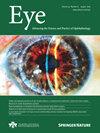超声引导下Ru106斑块近距离治疗弥漫性脉络膜血管瘤患儿渗出性视网膜脱离。
IF 2.8
3区 医学
Q1 OPHTHALMOLOGY
引用次数: 0
摘要
目的:评价超声引导下钌(Ru 106)斑块近距离放射治疗弥漫性脉络膜血管瘤(DCH)渗出性视网膜脱离的疗效。方法:回顾性分析超声引导下Ru 106斑块近距离放射治疗4例DCH伴全渗出性视网膜脱离的患儿。所有患者均给予肿瘤顶点40 Gy剂量。治疗结果为DCH消退、视网膜脱离消退、新生血管性青光眼的发生及其他放射相关并发症,经临床及B超检查评估。结果:共纳入4只眼,平均(中位,范围)年龄8.75岁(8.4,3-15)岁。术前肿瘤厚度5.0 (5.12,4.2-5.5)mm,视力0.8-2.8 LogMAR, 4只眼中有3只出现光感。一只眼睛因先前存在的继发性青光眼而接受了眼膜切开术治疗,并服用了局部抗高血压药物。平均随访14.6个月(10.5个月,6-30个月),所有患者肿瘤消退。术后肿瘤平均厚度降至2.05 mm (2.44 mm, 1.1-2.6 mm)。所有患者(4/4)视网膜脱离完全消退。所有患者的视力都保持稳定,没有患者出现新血管性青光眼或任何其他与辐射相关的并发症。结论:超声引导下Ru 106斑块近距离治疗是在无外束放射治疗的情况下实现DCH肿瘤消退和视网膜脱离的一种有效治疗策略。本文章由计算机程序翻译,如有差异,请以英文原文为准。

Ultrasound guided Ru106 plaque brachytherapy for treatment of exudative retinal detachment in children with diffuse choroidal haemangioma
To evaluate the efficacy of ultrasound-guided ruthenium (Ru 106) plaque brachytherapy for treatment of exudative retinal detachment in diffuse choroidal haemangioma (DCH). Retrospective analysis of four paediatric patients treated with ultrasound-guided Ru 106 plaque brachytherapy for DCH with total exudative retinal detachment directed to the thickest part of the DCH. A dose of 40 Gy to the tumour apex was delivered in all patients. The outcomes of treatment were regression of DCH, resolution of retinal detachment, development of neovascular glaucoma or any other radiation-associated complications which were assessed clinically and with B scan ultrasonography. There were 4 eyes included in the study, with a mean (median, range) age of 8.75 (8.4, 3–15) years. The pre-operative tumour thickness was 5.0 (5.12, 4.2–5.5) mm. The visual acuity ranged from 0.8-2.8 LogMAR and 3 of 4 eyes had only light perception at presentation. One eye had been treated with goniotomy for pre-existing secondary glaucoma and was on topical antihypertensive medications. At a mean follow-up of 14.6 months (10.5 months, 6-30 months), all patients showed regression of the tumour. The mean tumour thickness reduced to 2.05 mm (2.44 mm, 1.1–2.6 mm) post-operatively. All patients (4/4) had complete resolution of the retinal detachment. The visual acuity remained stable in all the patients with none of the patients developing neovascular glaucoma or any other radiation-related complications. Ultrasound-guided Ru 106 plaque brachytherapy is an effective treatment strategy as a primary treatment in the absence of external beam radiotherapy, to achieve tumour regression and resolution of retinal detachment in DCH.
求助全文
通过发布文献求助,成功后即可免费获取论文全文。
去求助
来源期刊

Eye
医学-眼科学
CiteScore
6.40
自引率
5.10%
发文量
481
审稿时长
3-6 weeks
期刊介绍:
Eye seeks to provide the international practising ophthalmologist with high quality articles, of academic rigour, on the latest global clinical and laboratory based research. Its core aim is to advance the science and practice of ophthalmology with the latest clinical- and scientific-based research. Whilst principally aimed at the practising clinician, the journal contains material of interest to a wider readership including optometrists, orthoptists, other health care professionals and research workers in all aspects of the field of visual science worldwide. Eye is the official journal of The Royal College of Ophthalmologists.
Eye encourages the submission of original articles covering all aspects of ophthalmology including: external eye disease; oculo-plastic surgery; orbital and lacrimal disease; ocular surface and corneal disorders; paediatric ophthalmology and strabismus; glaucoma; medical and surgical retina; neuro-ophthalmology; cataract and refractive surgery; ocular oncology; ophthalmic pathology; ophthalmic genetics.
 求助内容:
求助内容: 应助结果提醒方式:
应助结果提醒方式:


